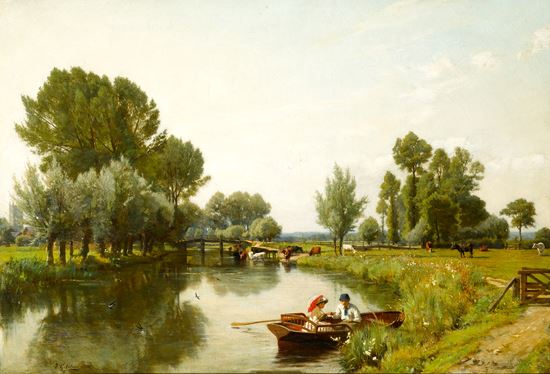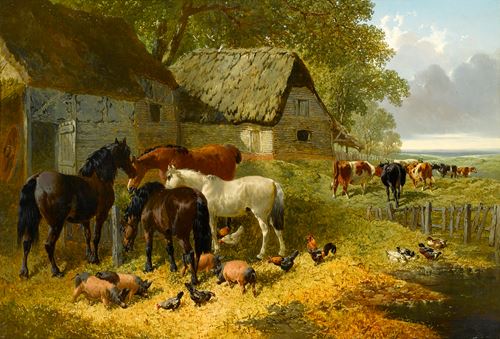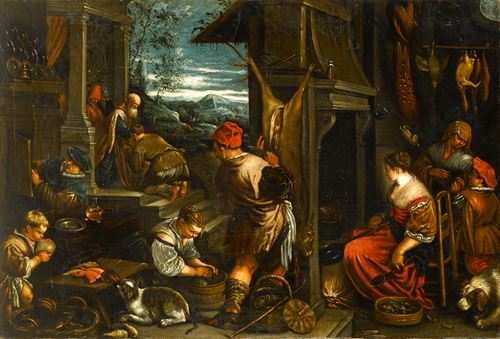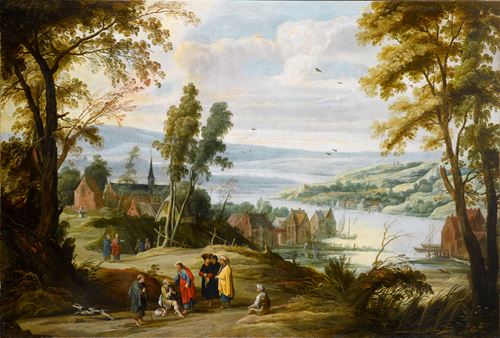rederick George Cotman
(Ipswich 1850 - Felixstowe 1920)
Boating on the Stour at Dedham
signed and dated ‘F.G. Cotman 1884’ (lower left)
oil on canvas
71.5 x 105.5 cm (28⅛ x 41½ in)
This idyllic scene focuses on the quint-essentially English pastime of boating, as a couple idly scull about on the River Stour, on a perfect summer’s day. In the foreground, nestled among fluttering white flag irises, a couple seated in a row boat push off from the river bank. The lady is dressed in a fashionable, cream full length dress and sports a crimson parasol, while her companion is attired in a white shirt and navy cap with matching tie. The tranquillity of the scene, and the sense of peace and solitude, are successfully evoked by the deeply recessive perspective and a deliberately uncluttered composition, allowing the raw elements of nature to communicate their inherent harmony.
A herd of cattle have ambled down to the water’s edge to slake their thirst, underlining the bucolic nature of the scene. The river itself is smooth and glassy, and attracts swallows who duck and dive, their reflections bouncing off its surface. In the distance, beyond the lush green grass behind a line of languid trees, the tower of Dedham Parish Church can be seen in the shade of a summer’s afternoon.
Dedham is a small village located on the border of Essex and Suffolk, and due to its picturesque location in the Stour Vale, was painted many times by Frederick George Cotman, and his associates of the Norwich School, although most famously it was depicted by John Constable. The Church of St. Mary the Virgin, seen in the background of the present work, was built in 1492 and still serves as a distinctive landmark, towering over the surrounding countryside.
Boating on the River Stour at Dedham is an exquisite example of Cotman’s work, comparable to another of his large scale works, Hill Top View, Norfolk Broads (Private Collection). Although Hill Top View is a more panoramic work, painted from a height, Cotman composes both works in a similar manner. The broad pale blue stripe of the river plunges straight back into the landscapes in both paintings, uniting foregrounds and middle grounds. On either side the water is flanked by towing trees and broad fields depicted in rich green. This palette of soft greens, whites and blues, which Cotman uses in both works, creates a sense of lightness and airiness, imbuing the landscapes with serene beauty.
Cotman was the son of Henry Cotman and a nephew of the celebrated painter, John Sell Cotman (1782-1842). Known predominantly for his portraits of London society and his highly finished narrative scenes, Cotman is also remembered for his impressionistic oils and watercolours of his native East Anglia which are among his most successful work. He entered the Royal Academy Schools in 1868 and became a regular exhibitor of both oils and watercolours, showing at the Royal Academy from 1871 onwards. His The Death of Eucles now in the Town Hall, Ipswich, won him the gold medal in 1873.
Cotman’s early watercolours were admired and collected by prominent artistic figures of the time including Frederic, Lord Leighton (1830-1896) and George Frederick Watts (1817-1904). In fact, Cotman collaborated with Leighton when the latter engaged him to help paint The Daphnephoria in 1876 (Lady Lever Art Gallery, Liverpool). Cotman was also employed in a similar capacity by the artist, Henry Tamworth Wells (1828-1903).
James McNeill Whistler (1834-1903) is known to have been an admirer of Cotman’s work and in a letter of 1888 to Walter Dowdeswell, he spoke approvingly of Cotman’s current work on exhibition, describing it as ‘very pretty.’
This idyllic scene focuses on the quint-essentially English pastime of boating, as a couple idly scull about on the River Stour, on a perfect summer’s day. In the foreground, nestled among fluttering white flag irises, a couple seated in a row boat push off from the river bank. The lady is dressed in a fashionable, cream full length dress and sports a crimson parasol, while her companion is attired in a white shirt and navy cap with matching tie. The tranquillity of the scene, and the sense of peace and solitude, are successfully evoked by the deeply recessive perspective and a deliberately uncluttered composition, allowing the raw elements of nature to communicate their inherent harmony.
A herd of cattle have ambled down to the water’s edge to slake their thirst, underlining the bucolic nature of the scene. The river itself is smooth and glassy, and attracts swallows who duck and dive, their reflections bouncing off its surface. In the distance, beyond the lush green grass behind a line of languid trees, the tower of Dedham Parish Church can be seen in the shade of a summer’s afternoon.
Dedham is a small village located on the border of Essex and Suffolk, and due to its picturesque location in the Stour Vale, was painted many times by Frederick George Cotman, and his associates of the Norwich School, although most famously it was depicted by John Constable. The Church of St. Mary the Virgin, seen in the background of the present work, was built in 1492 and still serves as a distinctive landmark, towering over the surrounding countryside.
Boating on the River Stour at Dedham is an exquisite example of Cotman’s work, comparable to another of his large scale works, Hill Top View, Norfolk Broads (Private Collection). Although Hill Top View is a more panoramic work, painted from a height, Cotman composes both works in a similar manner. The broad pale blue stripe of the river plunges straight back into the landscapes in both paintings, uniting foregrounds and middle grounds. On either side the water is flanked by towing trees and broad fields depicted in rich green. This palette of soft greens, whites and blues, which Cotman uses in both works, creates a sense of lightness and airiness, imbuing the landscapes with serene beauty.
Cotman was the son of Henry Cotman and a nephew of the celebrated painter, John Sell Cotman (1782-1842). Known predominantly for his portraits of London society and his highly finished narrative scenes, Cotman is also remembered for his impressionistic oils and watercolours of his native East Anglia which are among his most successful work. He entered the Royal Academy Schools in 1868 and became a regular exhibitor of both oils and watercolours, showing at the Royal Academy from 1871 onwards. His The Death of Eucles now in the Town Hall, Ipswich, won him the gold medal in 1873.
Cotman’s early watercolours were admired and collected by prominent artistic figures of the time including Frederic, Lord Leighton (1830-1896) and George Frederick Watts (1817-1904). In fact, Cotman collaborated with Leighton when the latter engaged him to help paint The Daphnephoria in 1876 (Lady Lever Art Gallery, Liverpool). Cotman was also employed in a similar capacity by the artist, Henry Tamworth Wells (1828-1903).
James McNeill Whistler (1834-1903) is known to have been an admirer of Cotman’s work and in a letter of 1888 to Walter Dowdeswell, he spoke approvingly of Cotman’s current work on exhibition, describing it as ‘very pretty.’




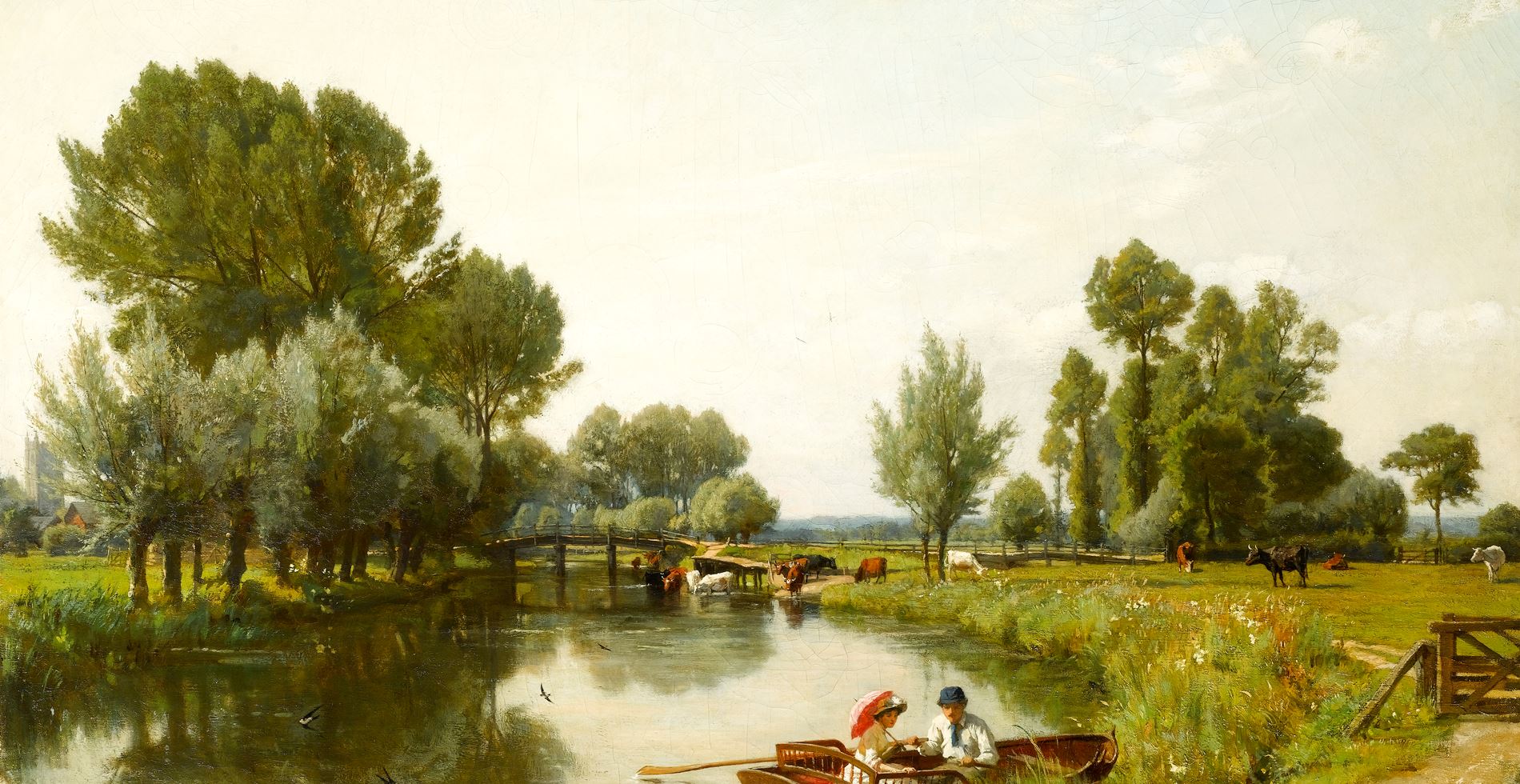
 contact
contact +44 20 7313 8040
+44 20 7313 8040


